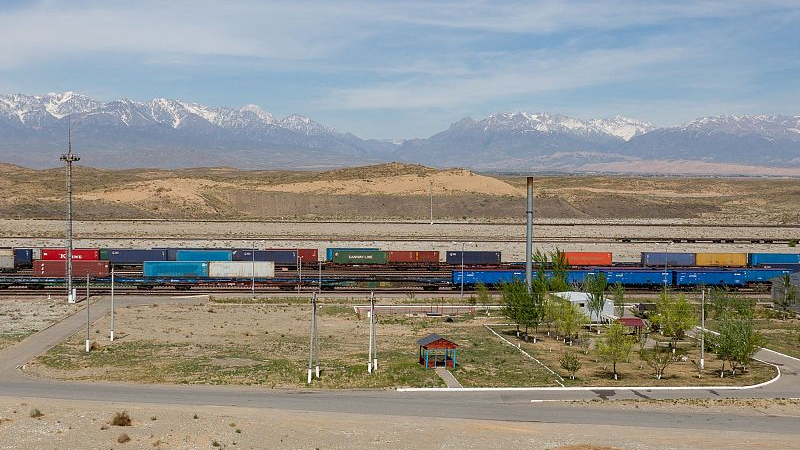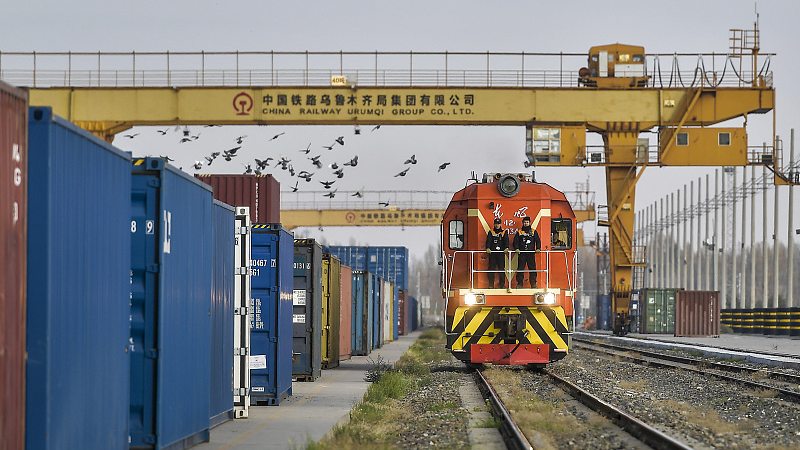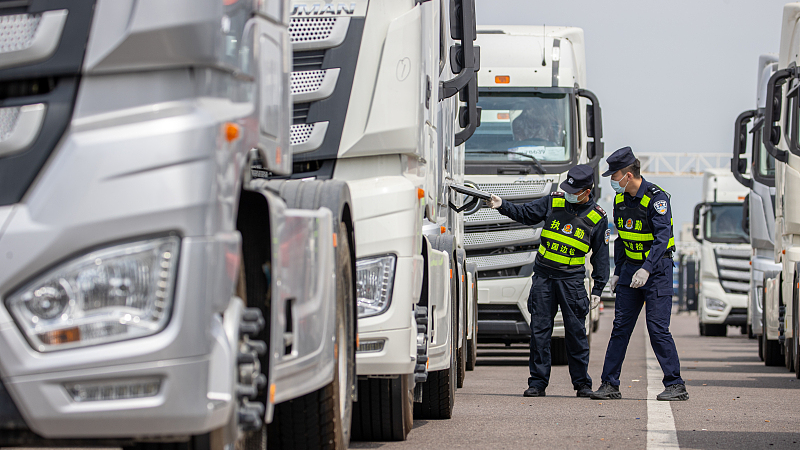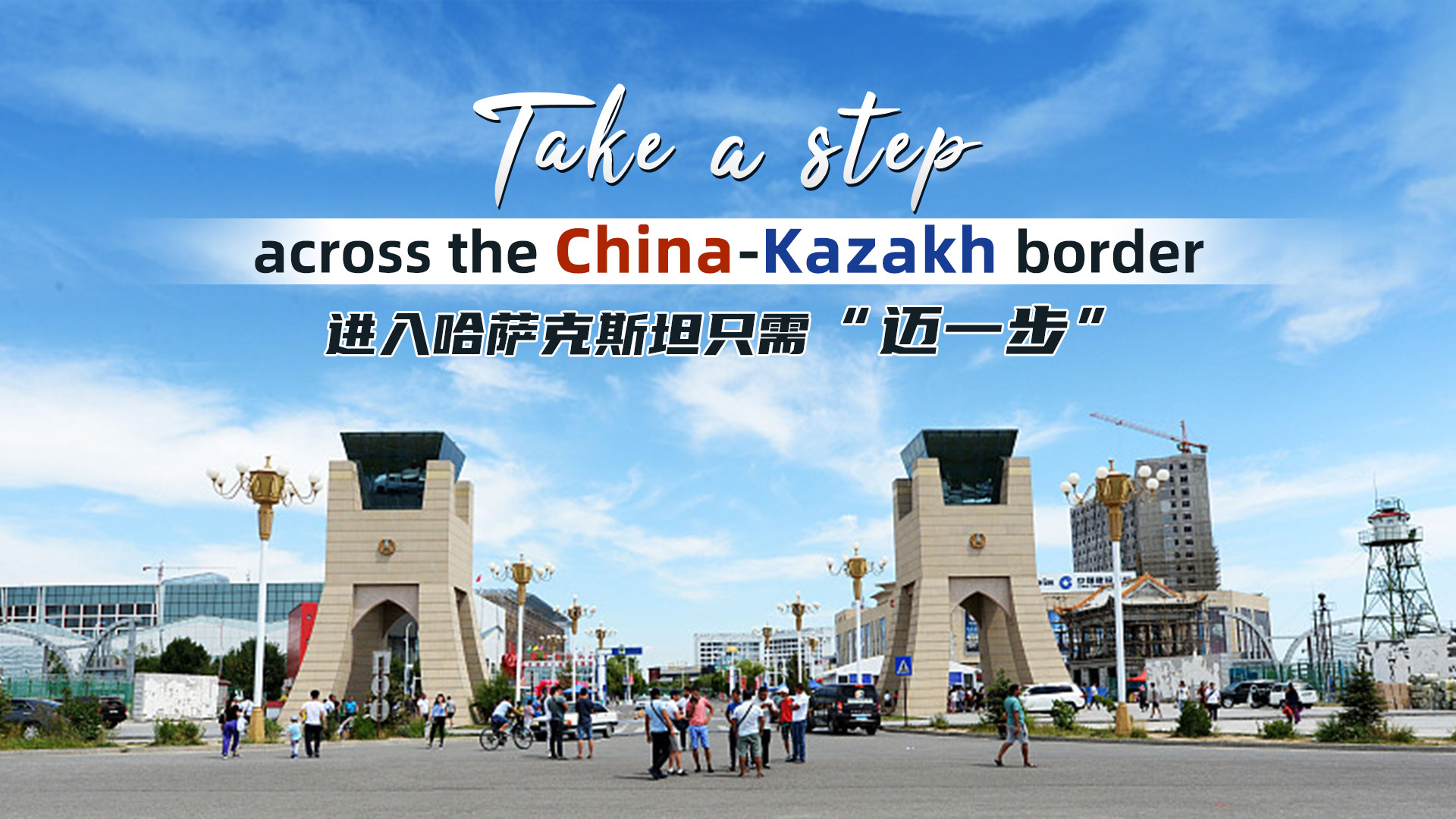
A view of Kazakhstan's Altynkol rail hub in Khorgos on the Kazakh side of the Kazakhstan-Chinese border in Kazakhstan on April 15, 2019. /CFP
A view of Kazakhstan's Altynkol rail hub in Khorgos on the Kazakh side of the Kazakhstan-Chinese border in Kazakhstan on April 15, 2019. /CFP
Trying to find the point on land farthest removed from the ocean will bring you to the Eurasian Pole of Inaccessibility, located at the China-Kazakhstan border. With endless steppes and white-capped mountain ranges in the distance, an unsuspecting traveler might occasionally spot a few yurts where the last surviving nomads from Central Asia still live today. For centuries, the region has remained largely untouched by modern developments that has swept other parts of the world.
Now, changes are happening fast, starting at some 130 kilometers from the Pole in the Chinese city of Horgos, and its twin from just across the border in Kazakhstan named Khorgos (note the spelling difference). Perhaps fittingly, the latter is now home to the world's largest dry port. Nestled in between the Tianshan range in China's western frontier in Xinjiang, the region has emerged as a critical junction in the largest development project in human history known as the Belt and Road Initiative, or BRI, which was put forward in 2013.
As a modern retake of the ancient Silk Road, which had brought unseen riches to kingdoms and empires in the past, the 2.0 version looks to build hundreds of new plants and pipelines as well as highways, railroads, airports and seaports in dozens of countries, ultimately linking China's rising middle class and burgeoning factories with the world via a vast network of land and sea routes supported by these new facilities. The end goal is "win-win cooperation" where all participating countries can benefit from increased regional interconnectivity in trade, culture and technology.
Horgos' unique geographic location serving as China's gateway to Central Asia and beyond has propelled it to the forefront of this hugely ambitious endeavor. It is now positioned to showcase the new possibilities that globalization and frictionless cross-border trade can offer and perhaps more importantly, the country's determination to develop its western part that has long paled in economic vitality compared to its eastern coast.

A China-Europe train pulls into the Horgos Railway Port in Xinjiang, China on November 8, 2023 /CFP
A China-Europe train pulls into the Horgos Railway Port in Xinjiang, China on November 8, 2023 /CFP
The sheer scale of BRI begins to sink in upon arrival at the city's railway port where gantry cranes can be seen towering over thousands of colorful containers stacked and lined alongside rail tracks like LEGO bricks, waiting to be transported into China or out into Kazakhstan. Then, a loud train horn tears through the still air, signaling its arrival as a few workers in safety helmets and yellow vests scramble and fall into position. As part of the China-Europe freight trains, they have transported a variety of commodities from Chinese tea and electronics to Spanish olive oil and French cosmetics since 2011, traversing thousands of kilometers across the Eurasian landmass.
As the train slowly pulled into the port, a railway official explained that as a former Soviet Republic, Kazakhstan uses a wider gauge track so the containers need to be reloaded here for them to be transported into China, which has adopted the "standard gauge" used more commonly in the world. In the past decade, the port has upgraded its infrastructure and optimized custom clearence procedures to meet increasing transit volume. In the first 10 months of this year, over 6,400 China-Europe freight trains passed through the railway port of Horgos, up 9.8 percent from last year, according to official statistics.
In a 2014 report by the World Bank, researchers said that the train routes along the Belt and Road Initiative offer unbeatable value in terms of speed and cost per kilometer. The freight trains also make sense from an environmental perspective, according to 2021 data in the Eurasian Rail Alliance Index which tracks emissions from trains. Compared to sea, road and air transportation, the China-Europe freight trains leave a significantly lower carbon footprint when all things are considered, such as the distance traveled and tonnage carried.
Besides railway, Horgos also boasts a robust road port where camels have been replaced by modern caravans dominated by 18-wheelers. At the waiting area, vehicles large and small line up to go through customs and security before crossing the border. In recent years, Xinjiang has enacted a series of policies to improve the efficiency of customs clearances. On August 14 this year, Horgos became the first road port in Xinjiang that went into around-the-clock operation, allowing goods to pass through at any time. Customs data shows that in the first three quarters this year, the highway port had recorded about 1.36 million tonnes in terms of its import and export volume of freight, up 115.3 percent from same period last year.

Police performs security checks to vehicles waiting to pass through the Horgos road port in Xinjiang, China on July 21, 2023 /CFP
Police performs security checks to vehicles waiting to pass through the Horgos road port in Xinjiang, China on July 21, 2023 /CFP
Yu Huan, deputy general manager of Jinyi Group, a local agricultural wholesaler and exporter established in 2010, said the improvement in efficiency has translated to real gains for the business.
"In the past, it took us at least 20 hours to transport a truckload of fruits and vegetables to Almaty in Kazakhstan. Now, it only takes about six hours, significantly reducing the loss of fruits and vegetables," Yu said.
During sunset, semi-trucks continue to pull up in the parking lot of the Jinyi group, getting ready to load fresh produce with origins in both local and inland provinces. Ilkham Vazhitov from Zharkent, Kazakhstan was among the truck drivers who have witnessed the rapid changes in Horgos' landscape. Over the past seven years, Vazhitov has been shuttling between the two countries with a Volvo semi-trailer truck that he purchased. He noted the convenience, safety and easy customs clearance of his experience but the high-pay is still the part that he savors.
"I'm very happy with my income, where do you think I can earn $10,000 (a month)," he said with a grin.
A 10-minute drive from the glittering high-rises in the city center is the Horgos International Frontier Cooperation Center, where the core ideas of BRI are more keenly felt. Here, people and goods flow freely across the border without visas or paying duties. At the Kazakh's side of the center, identified only by a bronze eagle statue that's hard to miss upon entrance, Kazakh tourists are dropped off by the busloads every five to ten minutes. Most of them come to the Chinese side for the bargains at the countless duty-free stores, and vendors that sell everything from TV sets to mink coats – both being among top-selling items.
03:08

The number of tourists picked up significantly this year, said the manager of the Golden Eagle Plaza Ji Gang, a calm and studious middle-aged man in navy windbreakers. After learning about the development of the cooperation center on the news, Ji decided to move across the country from his home in Jiangsu province to Horgos and test the waters for himself – a decision that he seems to be content with. Besides tourists, people also come here to explore and discuss business opportunities he said.
"Kazakh companies and businessmen have reached out to us for access to Chinese manufacturers to buy products," Ji said. "They're not only from Kazakhstan, we've also seen more from Russia, Kyrgyzstan, Uzbekistan, even European countries too."
This year, Almaty-based Bank CenterCredit moved into the campus, which provides financial services for shoppers in the form of loans and credits. They are especially helpful with big purchases such as Chinese plug-in electric vehicles that have become a huge hit in Central Asian as well as Russian markets. The bank's presence represents a vote of confidence from the Kazakh's side and helps inject more economic vitality into the future of the center, Ji said.
Ji's optimism is reaffirmed by the State Council's decision to create the Xinjiang Pilot Free Trade Zone (FTZ), which went into effect this month. As China's youngest FTZ, it includes three areas – Urumqi, Kashgar and Horgos – which adds up to an area of 180 square kilometers. They are expected to support the core area development of the BRI and play a significant role in building a "golden channel" between Asia and Europe as well as a bridgehead for China's westward opening up, according to a general plan released by the State Council.
"The Chinese and Kazakh governments have both shown great confidence in this place," he said. "That's why businessmen like us are willing to come invest and build things."
Video by Qi Jianqiang





